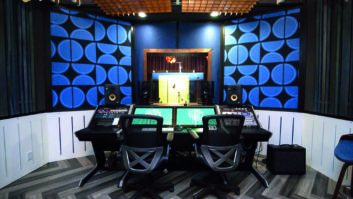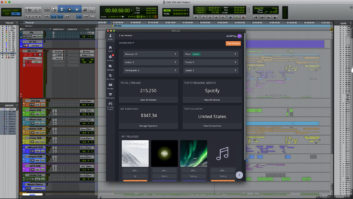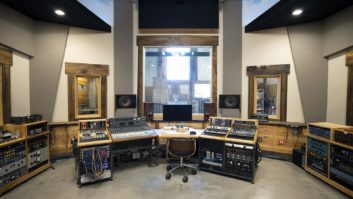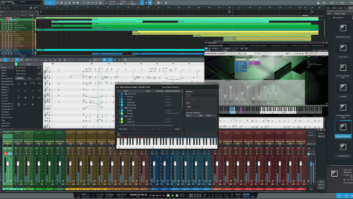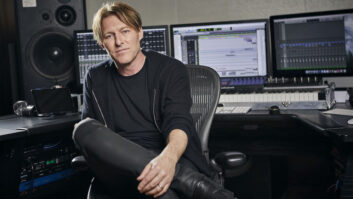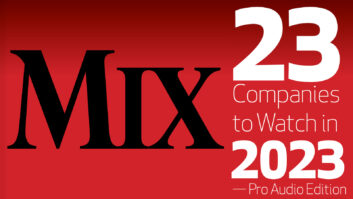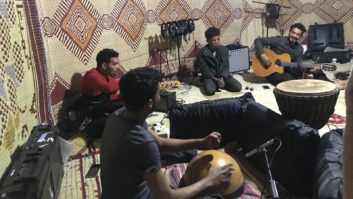
The past 12 months saw more and more people putting some form of production setup into their homes, in large part because of the pandemic. Whether they were pros in a work-from-home arrangement or enthusiasts creating a home studio for the first time, the process served as a learning experience as they got to grips with their environments’ acoustics and the introduction of audio tools. For many manufacturers, that process provided them with an educational opportunity, not just to promote their appropriate products, but also to help customers improve their skills while welcoming more people into the audio community.
Focusing on some essential components—microphones, audio interfaces and monitoring—a handful of manufacturers offer some product suggestions plus a few tips for anyone building or upgrading a home studio setup.
Gary Boss, marketing director, Audio-Technica U.S.

“For a single room, you’re most likely to be utilizing a cardioid or a directional pickup pattern 99.9% of the time, because you do not have a perfect acoustic space,” says Boss. “Make certain the dead spot—maybe curtains, a mattress up on end or a closet—is behind you to minimize any reflected signals.” Out of A-T’s offerings, then, he suggests considering the AT-2050 multi-pattern large-diaphragm microphone, which comes with a shock mount. “Houses tend to be thumpy and boomy, so you want to isolate that with a shock mount,” he says. “By having multiple polar patterns, you can coax different performances out of a single microphone.”
The next step up would be the AT-4040, Boss suggests. “It’s one of those mics that may be in your arsenal for your entire career.” The aspirational choice, he says, is the multi-pattern AT-4050. “It’s a little more expensive, but it’s in numerous professional studios around the world. Many professional producers and engineers have called it a ‘desert island’ mic.”
Boss also notes, “Headphones are a home studio necessity.” Audio-Technica’s ATH-M50x is a popular choice, he says, and anyone planning to track multiple people might consider the cost-effective ATH-M20x; the ATH-Pack5 bundles one M50 with four M20s.
Christopher Spahr, VP sales and marketing, USA, DPA Microphones

DPA Microphones are not inexpensive and may not previously have been considered for a home studio, says Spahr, but the price tag is deceptive, and perceptions are changing. Because DPA’s pencil mics are modular, he says, “You buy what you think is a really good small-diaphragm condenser for your acoustic guitar and then that capsule can be screwed off and put onto a different preamp and used for vocals.”
The “Lego mentality” of the company’s modular mic system, as Spahr calls it, “suits the home studio really well because you’re in limited space with a limited budget and you can turn this mic into all different kinds of things. You can buy one mic and do 20 things with it, as opposed to having to buy 20 different microphones.”
DPA doesn’t make many instrument-specific microphones, he says. “We only make mics that are flat and accurate. The idea is that whether you stick it in front of a 150 dB guitar amp or a singer or an acoustic guitar, it’s going to give you whatever you stick it in front of. It’s a mic that potentially can be used for a lot of different applications.”
How Pros Are Livestreaming During the Pandemic
Dan Hughley, marketing manager, Focusrite

Focusrite offers three lines of audio interfaces, says Hughley. “There’s something for everyone in each of those ranges, with different I/O configurations across the board.”
Focusrite’s entry-level interface is Scarlett, popular with podcasters and home music hobbyists. “Scarlett is the best-selling range of audio interfaces in the world, with over four million sold,” he reports, and comes with an Easy Start tool that guides audio newbies through setup. Units range from one to eight mic inputs. If that’s not enough, add an OctoPre eight-input expander, which plugs into the ADAT input on any brand of interface, he says.
The Clarett line offers a small step up in quality and dynamic range. “I own a Clarett; the conversion makes my ears happy,” says Hughley. The three Clarett options offer two to eight mic pres and a range of I/O. Scarlett and Clarett both feature an Air mode derived from Focusrite’s classic ISA mic pre, adding an EQ bump and, well, a sense of air. Both lines also ship with Focusrite Control software for configuration and routing.
At the top of the range is Red, the latest introduction being the Red 8Line, a 58-input Thunderbolt 3 interface with a variety of connectivity, including two Dante ports, that can toggle between two different DAWs. “The Red units will also get you into the world of immersive audio, with the amount of inputs and outputs,” says Hughley.
Will Eggleston, U.S. marketing director, Genelec

Genelec‘s Eggleston usually asks what type of work prospective customers do and how they do it, he says, including how loud the system needs to go. Whatever their space, they need to try to follow the basic guidelines of acoustics, in terms of the room’s behavior, he says.
“The character of the room is easily responsible for 40 to 50 percent of the sound of the speaker,” a figure that improves the closer they sit to the near field, he says. “As they get further into the reverberant field, or if the room is more reverberant in general, that’s a hard thing to fight.”
Orient the setup so that you are facing the shorter wall in a rectangular space, he advises. “That gives you the opportunity to have your mix space in the front half of the room, not the middle.
The budget may not stretch beyond minimal acoustic treatment, but even basic trapping will improve a room’s performance. “You want some control to about 1,000 Hz; you want to take some of the mid-range ringing out of the room if you can,” he says. “Can you get the speakers close to the front wall? That will improve the low end.”
Eggleston typically guides customers toward Genelec’s models with Smart Active Monitoring, a combination of DSP and software that compensates for a room’s shortcomings. “The calibration will always give you a good match between bass, mid-range and treble. It takes a lot of the guesswork out and gives you a lot of valuable information.”
Sterling Doak, director of marketing, Gibson/KRK

Space is always an issue with any home studio, says Doak. “You end up in a couple hundred square feet if you’re lucky. It’s easy to think you should get a pair of 8-inch monitors, but you find out right away that’s too much speaker.”
KRK’s good-better-best options start with the Classic 5, a basic 5-inch monitor, he says. “We wanted to produce something that has a really good response but meets a decent price point.”
As you get better at production, you may wish to outfit the space differently, he continues, pointing to the Rokit 5 G4 line, pictured on the cover in the 8-inch version at Grammy-nominated cellist Tina Guo’s studio, where she produces music for TV, film and games. “It allows you to EQ your space through DSP and is by far our most popular monitor.”
As for KRK’s best option, he says, “In a home environment, the V4 has a great response. The SPL is greater than a Classic 5, but because it’s only four inches, it doesn’t overpower the space.”
Whether a sub is warranted depends on the space, says Doak, and the type of work being produced. “It’s not outlandish to put an 8-inch sub in a home environment if you feel you need to hear that extra bass response.” A larger speaker will likely be too much, he cautions.
“My final piece of advice is to have a good set of headphones if you can’t have monitors in your space. I’ve been using our KNS 8400s and I’m really happy with them.”
Trevor Fedele, director, MXL Mics

“One of our approaches is to sell products while teaching people what the mics actually do,” says Fedele. MXL released its 990 and 770 bundles last year: “The idea was, I’ve just bought my [Focusrite] Scarlett, I’ve got some KRKs, I’ve got some headphones, what do I need for microphones?” he says. “I think we live in a world where everybody starts on Gearslutz and thinks they need a tube mic. You do not.”
MXL’s 990 and 770 are entry-level condenser mics, he says, and come with a shock mount with a built-in pop filter. “If somebody has no acoustic treatment, a condenser can set them up for failure—but it’ll be a learning experience,” he says.
Another option, MXL’s R144 ribbon mic, is also very inexpensive. “It’s not high-end, but it’s going to teach you what a ribbon mic sounds like. You’re going to get decision-making skills out of it,” says Fedele. None of these entry-level mics break the bank. “If somebody has $300 to spend, I’d probably tell them to try and get each kind of microphone rather than put it into a $300 condenser,” he says.
